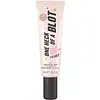What's inside
What's inside
 Key Ingredients
Key Ingredients

 Benefits
Benefits

 Concerns
Concerns

 Ingredients Side-by-side
Ingredients Side-by-side

Water
Skin ConditioningCyclopentasiloxane
EmollientCyclohexasiloxane
EmollientTitanium Dioxide
Cosmetic ColorantDipropylene Glycol
HumectantZinc Oxide
Cosmetic ColorantButylene Glycol
HumectantCetyl PEG/PPG-10/1 Dimethicone
EmulsifyingButylene Glycol Dicaprylate/Dicaprate
EmollientNiacinamide
SmoothingSodium Chloride
MaskingPEG-10 Methyl Ether Dimethicone
EmulsifyingMica
Cosmetic ColorantGossypium Herbaceum Extract
Skin ConditioningAnthemis Nobilis Flower Water
MaskingVolcanic Ash
AbrasiveChenopodium Quinoa Seed Extract
Skin ConditioningRosa Damascena Flower Water
MaskingDimethicone
EmollientDisteardimonium Hectorite
StabilisingAluminum Hydroxide
EmollientStearic Acid
CleansingDimethicone/Vinyl Dimethicone Crosspolymer
Skin ConditioningTriethyl Citrate
MaskingHydrogen Dimethicone
Adenosine
Skin ConditioningHydrogenated Lecithin
EmulsifyingDisodium EDTA
Phenoxyethanol
PreservativeCaprylyl Glycol
EmollientEthylhexylglycerin
Skin Conditioning1,2-Hexanediol
Skin ConditioningParfum
MaskingCitric Acid
BufferingSodium Benzoate
MaskingPotassium Sorbate
PreservativeChromium Oxide Greens
Water, Cyclopentasiloxane, Cyclohexasiloxane, Titanium Dioxide, Dipropylene Glycol, Zinc Oxide, Butylene Glycol, Cetyl PEG/PPG-10/1 Dimethicone, Butylene Glycol Dicaprylate/Dicaprate, Niacinamide, Sodium Chloride, PEG-10 Methyl Ether Dimethicone, Mica, Gossypium Herbaceum Extract, Anthemis Nobilis Flower Water, Volcanic Ash, Chenopodium Quinoa Seed Extract, Rosa Damascena Flower Water, Dimethicone, Disteardimonium Hectorite, Aluminum Hydroxide, Stearic Acid, Dimethicone/Vinyl Dimethicone Crosspolymer, Triethyl Citrate, Hydrogen Dimethicone, Adenosine, Hydrogenated Lecithin, Disodium EDTA, Phenoxyethanol, Caprylyl Glycol, Ethylhexylglycerin, 1,2-Hexanediol, Parfum, Citric Acid, Sodium Benzoate, Potassium Sorbate, Chromium Oxide Greens
Water
Skin ConditioningGlycerin
HumectantDimethicone
EmollientPentaerythrityl Tetrabehenate
EmollientButylene Glycol
HumectantMethyl Methacrylate Crosspolymer
Oryza Sativa Starch
AbsorbentHydroxyethyl Acrylate/Sodium Acryloyldimethyl Taurate Copolymer
Emulsion StabilisingSodium Acrylate/Sodium Acryloyldimethyl Taurate Copolymer
Emulsion StabilisingPhenoxyethanol
PreservativePolysilicone-11
Acrylates/C10-30 Alkyl Acrylate Crosspolymer
Emulsion StabilisingIsohexadecane
EmollientEnantia Chlorantha Bark Extract
Skin ConditioningEthylhexylglycerin
Skin ConditioningChlorphenesin
AntimicrobialSodium Hydroxide
BufferingDisodium EDTA
Polysorbate 80
EmulsifyingSodium Hyaluronate
HumectantTocopheryl Acetate
AntioxidantCaramel
Cosmetic ColorantSorbitan Oleate
EmulsifyingPolysorbate 60
EmulsifyingSorbitan Isostearate
EmulsifyingOleanolic Acid
Skin ConditioningCI 16035
Cosmetic ColorantWater, Glycerin, Dimethicone, Pentaerythrityl Tetrabehenate, Butylene Glycol, Methyl Methacrylate Crosspolymer, Oryza Sativa Starch, Hydroxyethyl Acrylate/Sodium Acryloyldimethyl Taurate Copolymer, Sodium Acrylate/Sodium Acryloyldimethyl Taurate Copolymer, Phenoxyethanol, Polysilicone-11, Acrylates/C10-30 Alkyl Acrylate Crosspolymer, Isohexadecane, Enantia Chlorantha Bark Extract, Ethylhexylglycerin, Chlorphenesin, Sodium Hydroxide, Disodium EDTA, Polysorbate 80, Sodium Hyaluronate, Tocopheryl Acetate, Caramel, Sorbitan Oleate, Polysorbate 60, Sorbitan Isostearate, Oleanolic Acid, CI 16035
Ingredients Explained
These ingredients are found in both products.
Ingredients higher up in an ingredient list are typically present in a larger amount.
Butylene Glycol (or BG) is used within cosmetic products for a few different reasons:
Overall, Butylene Glycol is a safe and well-rounded ingredient that works well with other ingredients.
Though this ingredient works well with most skin types, some people with sensitive skin may experience a reaction such as allergic rashes, closed comedones, or itchiness.
Learn more about Butylene GlycolDimethicone is a type of synthetic silicone created from natural materials such as quartz.
What it does:
Dimethicone comes in different viscosities:
Depending on the viscosity, dimethicone has different properties.
Ingredients lists don't always show which type is used, so we recommend reaching out to the brand if you have questions about the viscosity.
This ingredient is unlikely to cause irritation because it does not get absorbed into skin. However, people with silicone allergies should be careful about using this ingredient.
Note: Dimethicone may contribute to pilling. This is because it is not oil or water soluble, so pilling may occur when layered with products. When mixed with heavy oils in a formula, the outcome is also quite greasy.
Learn more about DimethiconeDisodium EDTA plays a role in making products more stable by aiding other preservatives.
It is a chelating agent, meaning it neutralizes metal ions that may be found in a product.
Disodium EDTA is a salt of edetic acid and is found to be safe in cosmetic ingredients.
Learn more about Disodium EDTAEthylhexylglycerin (we can't pronounce this either) is commonly used as a preservative and skin softener. It is derived from glyceryl.
You might see Ethylhexylglycerin often paired with other preservatives such as phenoxyethanol. Ethylhexylglycerin has been found to increase the effectiveness of these other preservatives.
Phenoxyethanol is a preservative that has germicide, antimicrobial, and aromatic properties. Studies show that phenoxyethanol can prevent microbial growth. By itself, it has a scent that is similar to that of a rose.
It's often used in formulations along with Caprylyl Glycol to preserve the shelf life of products.
Water. It's the most common cosmetic ingredient of all. You'll usually see it at the top of ingredient lists, meaning that it makes up the largest part of the product.
So why is it so popular? Water most often acts as a solvent - this means that it helps dissolve other ingredients into the formulation.
You'll also recognize water as that liquid we all need to stay alive. If you see this, drink a glass of water. Stay hydrated!
Learn more about Water